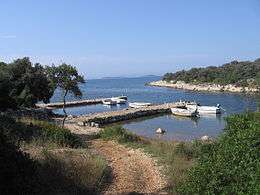Olib
 The Olib coast | |
|
| |
| Geography | |
|---|---|
| Location | Adriatic Sea |
| Coordinates | Coordinates: 44°22′N 14°46′E / 44.367°N 14.767°E |
| Area | 26.14 km2 (10.09 sq mi) |
| Highest elevation | 74 m (243 ft) |
| Highest point | Kalac |
| Administration | |
|
Croatia | |
| County | Zadar |
| Demographics | |
| Population | 140 (2011) |
| Pop. density | 5.3 /km2 (13.7 /sq mi) |
Olib (pronounced [ɔ̌lib]; Italian: Ulbo) is an island in northern Dalmatia, located northwest of Zadar, southwest of Pag, southeast of Lošinj and just east of Silba with an area of 26.14 km2.[1] The population is 140.[2]
History
First inhabited by settlers from the Roman Empire, Olib is first mentioned in documents from the 10th century as Aloep Island.
Croatian inhabitants arrived in the mid to late 15th century, from Vrlika in the Cetinska Krajina, fleeing the Ottoman invasions. The Chakavian dialect of the Croatian language is spoken on Olib and residents call themselves Olibjani.
The island has many historic buildings and ruins. Among these are the Parish Church Assumption of Mary with its collection of antiquities including Glagolitic codices dating back to the 17th century (housed in the treasury of the parish rectory), the stone Tower or "Kula" built for protection from pirates, and the ruins of St. Paul's Church and Monastery which was abandoned in the 13th century.
Modern-day Olib
The products of Olib include wine, olive oil, and cheese. Olib has no native freshwater sources. Consequently, nearly all homes on the island are built with cisterns to capture rainwater. There are also two communal wells available to residents.
Although the year-round population only hovers around 100, that number swells during the summer months when both descendants of the island's native population as well as international tourists come to enjoy the ample sea, sun, and relaxed atmosphere.
Olib is connected to the mainland by ferry to Zadar via the islands of Silba and Premuda. The journey to the mainland takes approximately two hours on a catamaran or three to five hours on a car ferry. Cars are forbidden to be used for transport on the island, instead having to be parked in a designated area adjacent to the harbor.
References
- ↑ Duplančić Leder, Tea; Ujević, Tin; Čala, Mendi (June 2004). "Coastline lengths and areas of islands in the Croatian part of the Adriatic Sea determined from the topographic maps at the scale of 1 : 25 000" (PDF). Geoadria. Zadar. 9 (1): 5–32. Retrieved 2011-01-21.
- ↑ http://www.dzs.hr/Hrv/censuses/census2011/results/censustabsxls.htm